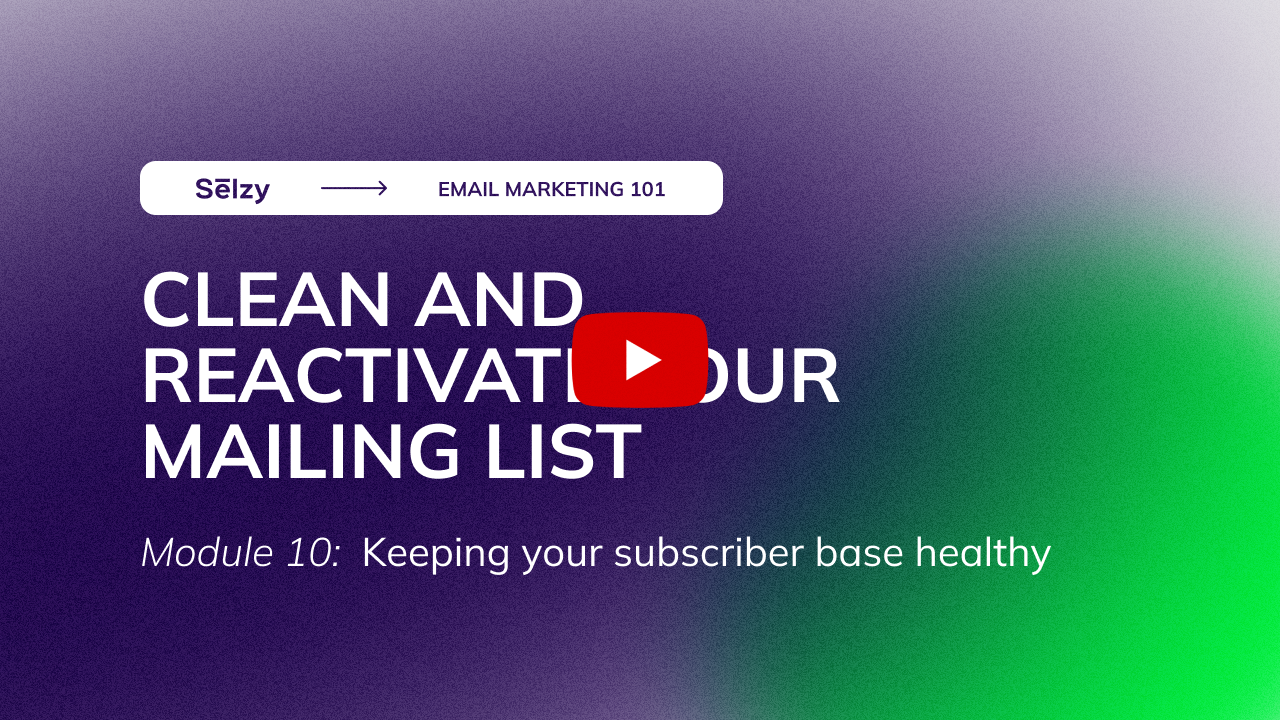How to Clean and Reactivate Your Mailing List
This is a transcript of lesson 24 of Email Marketing 101 Course by Selzy.

Welcome back! Let’s talk about how to clean and reactivate your mailing list and wrap up the module — and the whole course.
So, here we go.
You might wonder why you need to clean your email list
As mentioned earlier, keeping your mailing list in shape involves several steps. Preventive measures that we discussed in the previous lesson are where you begin. But while they are helpful, they can’t guarantee all low-quality addresses always stay away from your list.
That’s why you also need to sometimes clean up your email database. Ideally, it needs to be done every six months or at least once a year. This will ensure all low-quality addresses are scrubbed in a timely manner and your mailing list stays squeaky clean.
So, how do you clean it up? The best practices include these two steps:
- Email database validation
- A reactivation campaign.
First step should always be validation
because removing the “dead weight” is imperative before you do anything else.
So, what exactly is email validation, and how does it work?
Simply put, email validation is the process of checking email addresses from your mailing list to identify those that are non-existent, non-available, or contain errors. Such addresses are called invalid.
You can use specialized tools to validate an email database, especially a large one. These tools will validate your mailing list in just a few clicks and provide you with a detailed report. You can easily find them online, and some are even free to use.
For example, here’s what a report from My Email Verifier, a popular free email validation tool, looks like.

This visual is only available in a video lesson
Under this video, you’ll find a list of a few more select online email verifiers for you to try.
However, if your email marketing tool has an in-built validation tool,like Selzy, it is an even better option because it’s always more convenient to have everything in one place.
The good news is, virtually every decent email marketing software offers validation tools, so there’s really no need to use external ones. For example, Selzy clients can use the “Check contacts” tool when they first upload their list into the system.
To learn how to validate an email database with Selzy’s “Check contacts” tool step-by-step, check out our guide attached to this lesson.
When you have the report, proceed to the next step — that is, removing invalid contacts from your active subscribers list.
Your options are deleting invalid addresses permanently or moving them to a separate list. The latter option can come in handy if the list contains contacts that are only temporarily unavailable and might “come online” later.
After you’ve completed the validation process — that is, you have verified your mailing list and removed invalid contacts — you can move on to the next step: reactivation of those who haven’t been active in a while.
An email win-back campaign is targeted at subscribers who were active a while ago but stopped reacting to your emails. The purpose of such a campaign is to renew their activity — reactivate them, that is — as well as identify contacts that cannot be reactivated and, therefore, have to be removed.
Besides helping keep your list clean, reactivation campaigns come with other benefits.
These are:
Improving your sender reputation. Having fewer inactive subscribers on your list means higher open rates and click rates, which is good for your sender score.
Saving money on email marketing. Most ESPs offer pricing plans that depend on the volume of your mailing list. So, the fewer contacts you have, the less you pay — and there’s no use paying for inactive contacts anyway.
And driving extra profit. Turning dormant subscribers back into active customers is an effective way to increase sales — especially considering that ‘waking up’ these ‘sleeping beauties’ is usually cheaper than acquiring new clients.

This visual is only available in a video lesson
To get the most out of your reactivation campaign, you need to plan it properly
How do you do it? Everything starts with a plan!
Planning a reactivation campaign typically includes four steps.
These are:
- Segmenting the audience
- Devising a strategy
- Setting up the campaign
- Running tests and analyzing results.
Because reactivation emails are only sent to a portion of your database — namely, to unengaged subscribers — segmenting your audience to prepare a list of such contacts always comes first.
You can segment your list by engagement level — for example, by specifying the date they last opened your email or clicked on a link.
To learn more about how to segment your contacts, follow the Recommended Reading section under this video to access our guide on list segmentation.
Take care of the campaign strategy and the right content for your reactivation emails
Typically, a reactivation campaign is a short email sequence containing two to three emails.
Its structure usually goes something like this.
The first email is a brief introduction. Here, you explain why you’re writing and inform the readers they will be unsubscribed if they no longer wish to receive your emails.
But how exactly does segmentation help? Well, here’s the magic that it can do.

This visual is only available in a video lesson
Alternatively, you can focus on the emotional side and start your win-back campaign with a classic “we miss you” email.

This visual is only available in a video lesson
The second one is a compelling offer. That’s where you provide the reasons for your subscribers to re-engage with your brand and offer something valuable as a hook.

This visual is only available in a video lesson
And the final one is a farewell message. This email is for those who failed to engage with the previous two. Here, you thank the readers for being with you and say goodbye, informing them they have been unsubscribed.

This visual is only available in a video lesson
But of course, this structure may vary. For example, you may extend the sequence by sending out more than one offer or including an extra ‘final note’ before you bid farewell..
Another option is to go with ready-to-use reactivation campaign templates from your email service provider. These automated chains typically include triggered emails that will help optimize your efforts and achieve the maximum result.
As for the time limits, there are no strict rules here. The general recommendation is that a typical reactivation campaign should run for at least a week.

This visual is only available in a video lesson
One more important thing to mention here is, it’s always best to run A/B tests before launching your reactivation campaign full-scale. The reason is that reactivation emails tend to be more provocative than other emails — so it’s vital to test the waters to avoid making things worse by being too bold. Before launching A/B tests, you can re-watch lesson 2 of module 6 where we discussed the process in detail.
After your reactivation campaign wraps up, it’s time to look into the results
They can vary greatly from campaign to campaign. However, it’s proven that win-back campaigns actually work. For example, according to one study by Return Path, the overall open rate for win-back campaigns is 14%. There are also case studies that showed an up to 44% re-engagement rate.
And that’s it as the basics go. But there’s still more you can do. So now, we’ll share some tested tips to ensure subscribers open your reactivation emails and click to stay on the list.
First, make sure you come up with a compelling subject line
Think of something more creative than usual to make your subject line stand out, but don’t forget to test variations before mass emailing to reduce risks.

This visual is only available in a video lesson
Then, try offering an incentive
In re-engagement emails, discounts and special offers typically work best. To highlight your offer, feature it in your subject line. Then, proceed with the details in the email body.

This visual is only available in a video lesson
If you’re willing to go the extra mile, offer something really exclusive to set you apart from the competition.
You can also emphasize what they’re missing
Focus on the best value your emails provide to your subscribers and leverage their fear of missing out.

This visual is only available in a video lesson
Another effective way is to give them options
Offer dormant subscribers to send emails less frequently and let them choose the types of emails they’d like to receive if you have that option.

This visual is only available in a video lesson
You can also remind them they can follow you on social media and offer to unsubscribe right away if that’s what they prefer.
And finally, you can ask them directly
An honest, straightforward approach often works best. So, just explain how losing touch with them makes you feel and ask them plainly if they’d like to stay or prefer to go

This visual is only available in a video lesson
And… that’s a wrap!
This was the final lesson of Selzy’s email marketing course. Now, you’ve seen every step of an email marketing journey: from starting and growing your email list, creating a beautiful email and analyzing it, right up to bringing dormant subscribers back to life — and everything in between.
We hope you’ve enjoyed the ride!
Now, you’re ready to take your email marketing strategy to the next level. Good luck!
This is a transcript of lesson 24 of Email Marketing 101 Course by Selzy.